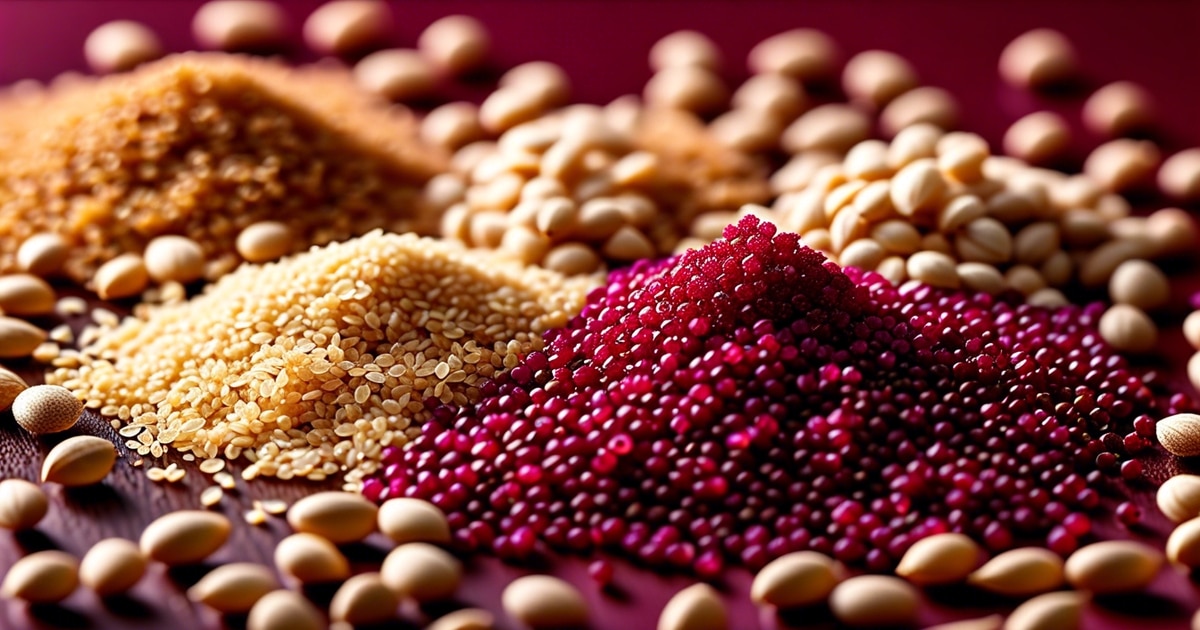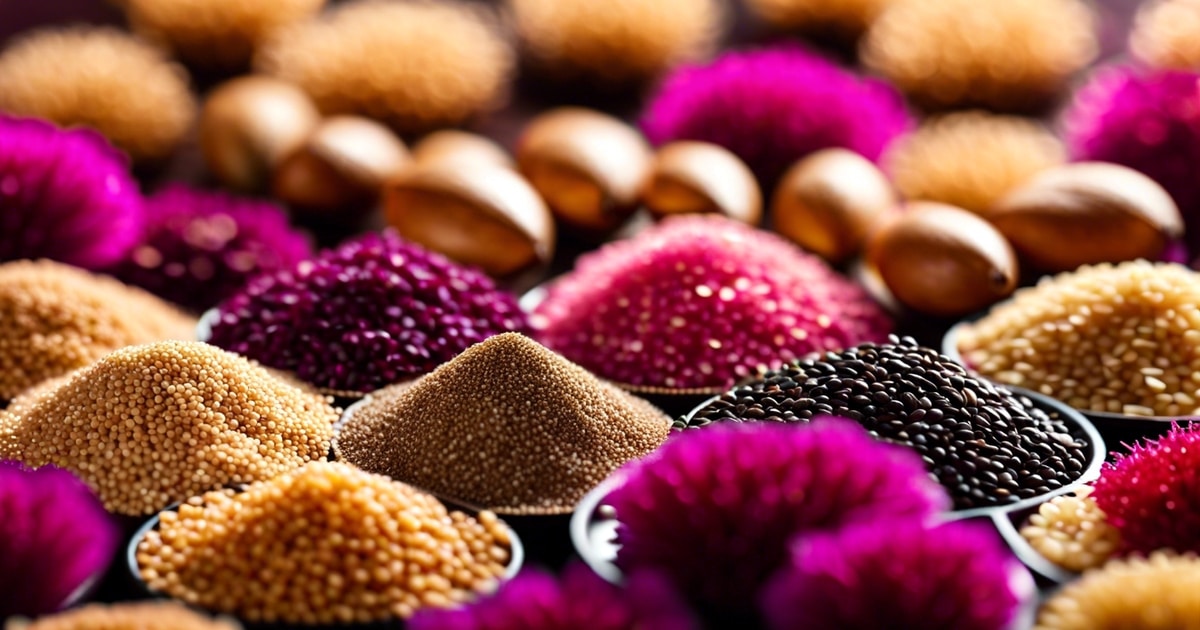Key Takeaways
- Choose based on nutrition: Consider the nutritional profiles of amaranth and quinoa, cereal grains, to decide which one suits your dietary needs best.
- Experiment in the kitchen: Try different cooking methods and recipes with amaranth, quinoa, and cereal grains to explore their culinary versatility.
- Be mindful of food allergies: When incorporating amaranth and quinoa into your diet, be aware of their gluten-free status and potential allergenicity.
- Support sustainability: Understand the environmental impact of both grains and food and choose one that aligns with your values for a more sustainable choice.
- Balanced diet: Incorporate a variety of grains, food, and vegetables, including amaranth and quinoa, to ensure a well-rounded intake of essential nutrients.
- Diversify your meals: Mix up your food by alternating between amaranth and quinoa to take advantage of each grain’s unique nutritional advantages.
- Let’s look at the amaranth vs quinoa debate!
Understanding Amaranth and Quinoa
Family Differences
Amaranth and quinoa food belong to different plant families: amaranth is part of the Amaranthaceae family, while quinoa comes from the Chenopodiaceae family. Despite both being ancient pseudo-cereals, their genetic makeup sets them apart. Both grains are technically seeds, not true cereals like wheat or rice. This characteristic makes them suitable for those with gluten sensitivities and allergies, as they are naturally gluten-free.Nutritional Value
When comparing the nutritional content of amaranth and quinoa varieties, there are slight differences. For example, quinoa is higher in proteins compared to amaranth but contains less fiber. On the other hand, amaranth offers more calcium and iron than quinoa. Let’s examine some key differences in diet, fiber, and antioxidants between these two superfoods.- Both are excellent sources of plant-based protein.
- Quinoa has a nuttier flavor profile than Amaranth’s slightly earthy taste.
- Amaranth tends to be smaller in size than quinoa seeds.
Historical Background of Amaranth and Quinoa

Ancient Grains in Central and South America
Amaranth, an ancient grain, was significant culturally important to the Aztecs. It was a staple food that dates back centuries in Central and South America. The crop’s history is deeply intertwined with the traditions and livelihoods of indigenous communities. Quinoa, another ancient grain, has a rich cultivation history spanning over 5,000 years in the Andes region. This nutrient-dense seed, rich in fats, was a vital part of the Inca diet and played a crucial role in their agricultural practices. Its resilience to harsh conditions made it an essential crop for survival.Suppression by Spanish Conquistadors
The Spanish conquistadors arrived in Central and South America during the 16th century, changing local agriculture. They suppressed the cultivation of amaranth due to its religious significance among indigenous populations. The conquerors aimed to impose their crops like wheat, altering the crop diversity of the region.- Pros:
- Rich cultural heritage tied to ancient civilizations.
- Nutrient-dense properties are beneficial for health.
- Cons:
- Disruption of traditional farming practices.
- Loss of biodiversity as certain crops were favored over others.
Nutritional Value of Amaranth vs Quinoa
 Protein Content
Protein Content
Amaranth boasts a high protein content, making it an excellent choice for those looking to increase their protein intake. Quinoa, on the other hand, is considered a complete protein source since it contains all nine essential amino acids vital for bodily functions.
Both amaranth and quinoa are great options if you’re seeking nutrient-dense foods that offer substantial amounts of protein. While amaranth is particularly rich in this macronutrient, quinoa is a complete source due to its amino acid profile.
Micronutrients and Carbohydrates
In addition to proteins, amaranth provides essential micronutrients like calcium and iron. These minerals are crucial for bone health and overall well-being. Similarly, although quinoa may not be as abundant in these specific micronutrients, it compensates by offering various vitamins and minerals necessary for optimal health. Both grains serve as excellent sources of complex carbs when focusing on carbohydrates. Compared to simple sugars in processed foods, these carbohydrates provide sustained energy release throughout the day.Protein, Carbohydrate, and Fiber Comparison
Protein Content
Amaranth contains slightly more protein per serving than quinoa, making it a great choice for those looking to increase their protein intake. Quinoa also offers a good amount of protein but falls slightly behind amaranth. Both grains are considered complete proteins, providing all the essential amino acids our bodies need. This makes them valuable protein sources for individuals following plant-based diets or looking to diversify their protein sources.Carbohydrate and Fiber
Quinoa has a lower carbohydrate content than amaranth, which can be beneficial for individuals monitoring their carbohydrate intake. However, both grains contain complex carbohydrates, sustaining energy release throughout the day. Both amaranth and quinoa are excellent sources. Due to their high fiber content, incorporating these grains into your diet can help promote healthy digestion. Fiber is essential for maintaining gut health and aiding digestion by promoting regular bowel movements.Vitamins, Minerals, and Antioxidant Levels
Vitamin Content
 Quinoa is rich in vitamins B and E, essential for overall health. These vitamins contribute to energy production, skin health, and immune function. In comparison, amaranth contains lower levels of these vitamins.
Quinoa is rich in vitamins B and E, essential for overall health. These vitamins contribute to energy production, skin health, and immune function. In comparison, amaranth contains lower levels of these vitamins.
- Quinoa: High in vitamin B6 and E
- Amaranth: Lower vitamin content compared to quinoa
- Quinoa: Contains less calcium, magnesium, phosphorus
- Amaranth: Rich in calcium, magnesium, phosphorus
Antioxidant Properties
Both grains are packed with antioxidants that help protect cells from damage caused by free radicals. These compounds are crucial in reducing inflammation and lowering the risk of chronic diseases like heart disease.- Both grains have high antioxidant levels.
Gluten-Free Status and Allergenic Potential
Gluten-Free Nature
Both amaranth and quinoa are safe for individuals with celiac disease or gluten sensitivity, as they are naturally gluten-free. This makes them excellent alternatives to gluten-containing grains like wheat, barley, and rye. Amaranth and quinoa offer a nutritious option for those seeking gluten-free alternatives. They can be used in various dishes like salads, soups, or even baked goods without triggering any adverse reactions related to gluten intolerance.Allergic Reactions
While rare, some people may experience allergic reactions to amaranth or quinoa due to their distinct protein compositions. These allergies can manifest as skin rashes, digestive issues, or more severe symptoms requiring immediate medical attention. Individuals with known allergies should exercise caution when consuming amaranth or quinoa products. Cross-contamination during processing is a potential risk factor that could lead to inadvertent exposure for those with severe allergies.Cooking Methods and Culinary Considerations
Boiling Techniques
Both amaranth and quinoa are cooked similarly by boiling in water or broth. They absorb the liquid as they cook, becoming tender. Amaranth releases starch during cooking, giving it a slightly sticky texture, while quinoa retains its fluffy consistency. Amaranth’s stickiness makes it ideal for thickening dishes like porridges or stews, whereas quinoa’s fluffiness works well in salads or as a side dish. The versatility of these grains allows them to be used in various meals ranging from breakfast porridges to hearty dinner salads.Culinary Applications
When considering which grain to use, think about the final texture you desire in your dish. Amaranth might be the better choice if you want a creamy consistency with chewiness. On the other hand, if you prefer light and fluffy grains that hold their shape well in salads or pilafs, then quinoa is an excellent option. Incorporating both amaranth and quinoa into your meals adds variety not just in taste but also in texture. Experimenting with these different types of grains can elevate your dishes by providing unique flavors and nutritional benefits.Environmental Impact and Sustainability
Soil Degradation Concerns
The high demand for Quinoa cultivation has led to soil degradation in some regions. This issue arises due to the intensive farming practices required by quinoa, impacting the soil quality negatively over time. On the other hand, Amaranth is more sustainable because it needs less water and can grow well in various climates. Its adaptability makes it a more environmentally friendly option compared to quinoa, which requires specific conditions for optimal growth. Supporting small-scale farmers practicing sustainable agriculture plays a crucial role in ensuring the long-term viability of both grains.Importance of Sustainable Farming
Small-scale farmers adopting organic farming methods contribute significantly to environmental sustainability by reducing chemical inputs that harm ecosystems. By promoting fair trade practices and supporting these farmers, consumers can actively participate in preserving the environment while enjoying nutritious grains like amaranth and quinoa.- Pros:
- Less water usage
- Diverse climate adaptation
- Supports small-scale farmers
Frequently Asked Questions
FAQ
Is amaranth or quinoa better for protein intake?
Amaranth and quinoa are both excellent sources of plant-based protein. Amaranth has slightly more protein per serving than quinoa, making it a great choice for those looking to boost their protein intake naturally.Are amaranth and quinoa suitable for gluten-free diets?
Yes, both amaranth and quinoa are naturally gluten-free grains. They are safe options for individuals with celiac disease or gluten sensitivity seeking nutritious alternatives in their diet.– What Nutritional Benefits Does Amaranth Have Compared to Quinoa?
Amaranth and quinoa are both nutritious grains, but the health benefits of amaranth are impressive. Amaranth is packed with protein, fiber, and essential vitamins and minerals like calcium, magnesium, and iron. It is also gluten-free, making it a great option for people with dietary restrictions.

